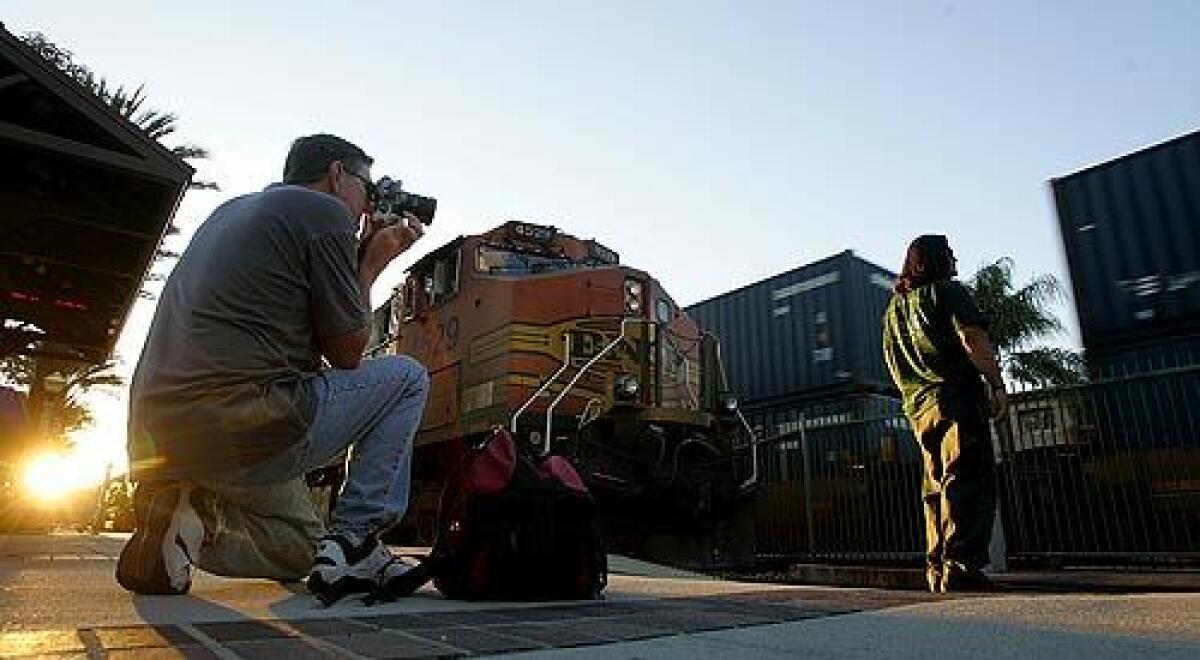Train hobbyists are loco for that motion

- Share via
It’s another Friday night at the Fullerton train station, which is full of the usual types: commuters with briefcases, people sprinting over a bridge because they found themselves on the wrong side of the tracks, families struggling with suitcases.
At one end, a group of men has gathered. Few ever pay them much mind, but the longer you look, the more they stick out, because they have been at the train station for a very long time, though they have nowhere to go.
They are members of a network of railroad fanatics -- hobbyists who study trains, photograph trains, videotape trains and ride trains, all with a fervor that makes birders, ham radio operators and the like seem like laggards.
Dropping in here helps one understand a confounding issue raised by the Sept. 12 Metrolink crash: why a group of teenagers had been exchanging text messages that day with engineer Robert M. Sanchez.
It turns out that the teens were fledging members of this network, a world that is virtually unknown except among the enthusiasts themselves and the engineers who offer them a tired wave at the station. But there are hundreds of thousands of them -- across the United States, in India, Australia, Zimbabwe -- hobbyists who are known, variously, as railfans, cranks, trainspotters and gunzels.
The most die-hard are known as foamers -- a term believed to have originated as an insult, used to describe people who get so excited at the sight of a train that they foam at the mouth.
Some refuse to use the word “foamer.” (These are sensitive people and not without reason; in England, “trainspotting” is a euphemism for useless activity.) Others have appropriated the word for themselves, an exercise in a kind of geek pride.
Whatever they call themselves, they seem to speak in a foreign language -- of wigwags and hoggers, shooters and boomers, varnishes and highballs. Some speak elegantly of the rails’ role in the development of the West. Many speak of trains with reverence, not as a means of transit but as a rolling metaphor. Train travel, they believe, fosters a sense of community and cooperation sorely missing in today’s world -- certainly on the freeways of Southern California.
At its heart, the hobby has the simplest of foundations: the might and majesty of the machines themselves. The enthusiasts see what most do not: tons of steel ferrying businesspeople, toys from China, huge tanks of natural gas, all sharing the same space without incident -- except for those rare, terrible moments when the whole thing falls apart.
“The power is just so immense,” said Scott Zechiel, a software engineer, standing on the Fullerton platform.
Behind him, train after train rumbled in, each its own beautiful mess, all bellowing engines and hissing brakes. The largest of the trains, typically the freights, cast off enough of a breeze that everyone’s hair puffed up a bit as they passed.
“We like it when the ground shakes under our feet,” Zechiel said. “We like the sounds, the screeches. We can’t get enough of it. So we keep coming back.”
In Southern California, Fullerton is foamer central.
The station is friendly to railfans -- which is not true of some others -- and is pleasant and comfortable, with shade canopies and cafes. But mostly it’s about the traffic; some days 100 or more trains pass through, and it’s an unusual blend of passenger trains and freights.
Most of the teens who knew Sanchez were Fullerton fixtures. They were often seen racing down the platform, cameras and tripods over their shoulders, to get the best shots of an oncoming train. Indeed, one of the first places several of the friends went after the crash was to the Fullerton station, where they could clear their heads and be with their own.
Zechiel, 44, is another regular. He bought his home in nearby Yorba Linda largely because it overlooks the tracks. Since 1997, with an informal group that calls itself the Fullerton Foamers and Foto Society, Zechiel has spent every Friday and Saturday night watching the trains. He figures he misses about four weekends a year, when he’s sick or when he is traveling -- “which is, of course, by rail,” he said.
On busy nights, there are five or six similar gatherings of railfans at the Fullerton station, sometimes as many as 50 railfans in all. Engineers have taken to calling it “Foamerton.”
The FF&FS, as Zechiel’s group is known, is tight-knit and well-organized. Members bring scanners to listen to conversations between engineers and conductors and a laptop programmed to replicate what dispatchers see at their desks. Many members are published photographers; during lulls between trains, they show slides of trains set to the music of Moby and U2.
Together, they make regular trips to the Cajon Pass, a popular gathering place for train lovers because of dramatic backdrops and track assemblies considered to be engineering feats. One trip, each January, is called “The Big Cajona”; they camp out with a luau theme.
“Basically, we sit around solving the world’s problems and complaining about our jobs. Then a train comes, and everything stops. We all watch the train. Then the train passes on and we get back to it,” said Jeffrey Bass, 48, who manages the parts department at a car dealership. “Everybody has their own interest. This is ours.”
Rail enthusiasts have long had a delicate relationship with the industry.
“I kind of grew up with them,” said Tom Dinger, a Southern Pacific and Amtrak engineer for 43 years, based in Southern California, before he retired two winters ago. “I think they’re harmless. They just have deep affection for trains. It’s kind of a strange phenomenon. But I never had a problem with them.”
But there have been some aggressive railfans who have crossed the line -- trespassing to get a photo, for instance, even stealing pieces of equipment for souvenirs. Increasingly, railfans have become rail professionals themselves -- engineers, conductors, dispatchers -- which has become the source of considerable tension.
“There’s been a kind of silent invasion,” one Amtrak engineer said in an interview. He spoke on condition of anonymity because he did not want to be “outed” as a railfan.
“I stay in the closet,” he said. “I don’t advertise too much that I’m a train buff, because I’ll be lumped in with them, with the ones who aren’t quite extremists but can’t keep their interest sufficiently under wraps.”
The Chatsworth crash -- and revelations that Sanchez was in contact with railfans while on the job -- caused a surprisingly caustic backlash against the hobbyists. On one website that is considered a must-read among engineers, an entry titled “The End of Foamers” was posted after the crash.
“This is a scary, high-stakes job where each and every one of us is at risk of being involved in a terrifying and catastrophic wreck. . . . Yet there are those people who act like they’re running the Disneyland railroad or up on a stage,” the post read. “If anything good is to come out of this awful week I hope it’s the complete eradication of foamers from railroad property. . . . If you want to foam out, go to a railroad museum.”
The rail companies have not figured out how to deal with railfans.
At times they have shunned them, as when officials erected an 8,500-foot-long fence to keep railfans away from the tracks near the Cajon summit.
On the other hand, Burlington Northern Santa Fe has begun a formal program that effectively deputizes railfans to keep an eye out for security threats. Some engineers have been encouraged to interact with younger railfans because they are seen as the future ranks of professionals, not to mention articulate lobbyists for the future of passenger rail -- a future that has not always looked bright.
The trend lines are on the railfans’ side.
The hobby has exploded in recent years. There are railfanning magazines. You can download freight train ring tones. There are rail “cruises” on refurbished antique locomotives. There are hundreds of websites, on which hobbyists dissect the angle of a particular engine’s exhaust flange or the letter that President Ford sent to Congress in 1974 while vetoing a federal railroad retirement benefits package.
Towns across the nation have discovered that although they are in the middle of nowhere -- perhaps because they are -- they have become popular railfanning destinations.
Rochelle, Ill., a town of 9,000 with a renowned freight crossing, built a park on an elevated piece of land where railfans can watch trains, complete with speakers broadcasting the transmissions of engineers and conductors. This summer, North Platte, Neb., opened a $4.5-million, 15-story-high platform where railfans can watch the action at the Bailey Yard, billed as the largest rail yard of its type in the world.
“We get people from every age group, from all walks of life. Everyone can make of it what they want,” said Todd DeFeo, the Atlanta-based editor of www.railfanning.org, one of the more popular hobby websites. “It’s a nice hobby.”
More to Read
Sign up for Essential California
The most important California stories and recommendations in your inbox every morning.
You may occasionally receive promotional content from the Los Angeles Times.














